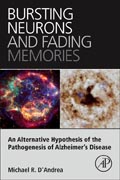
Bursting Neurons and Fading Memories: An Alternative Hypothesis of The Pathogenesis of Alzheimers Disease
D'Andrea, Michael R
Advances in Alzheimer's disease (AD) research have been challenging and without major breakthroughs in understanding its pathological basis. The reigning (and sole) hypothesis suggests that AD is the result of extracellular amyloid deposition that seeds to form amyloid plaques, which then grow and kill neighboring neurons. However, there are several inconsistencies with this hypothesis, not to mention the inability to show clinical benefit in several failed clinical trials by pharmaceuticals (i.e., Pfizer, Eli Lilly, Johnson & Johnson). It is fundamentally risky to drive the majority of AD research on this single amyloid hypothesis without exploring and testing other alternatives to the causes of AD. Through the presentation of many scientifically peer-reviewed publications, this book explains the Inside-Out hypothesis on how amyloid escapes the circulatory system through a dysfunctional blood-brain barrier into the brain to bind to the alpha 7 nicotinic acetylcholine receptor on pyramidal neurons that, over time, internalize excessive amounts, resulting in neuron death and lysis. This simple mechanism readily explains the composition of plaques, as well as why plaques are of particular sizes, shapes, and location. Based on the current direction of research in the field, this hypothesis appears years from any research and development activity. * The clear, compelling, and unifying Inside-Out hypothesis of AD is brought to life through a string of scientific publications, synthesizing many known features of disease pathology * A high-level text on AD pathology, the current state-of-the-art, and suggestions for progress in a stagnating field * Point-by-point discussion on the issues surrounding the current amyloid cascade, and possible reasons why current clinical trials have failed * Contains high-quality photomicrographs in support of the Inside-Out Hypothesis using single, double, and triple immunohistochemistry on human AD CNS tissues * Chapters address the need for a unifying plaque nomenclature, the importance of intracellular amyloid, the blood-brain barrier, inflammation, and autoimmunity INDICE: Introduction: The Current State of Alzheimer's Hypotheses1. What is a Plaque?2. Presenting the Inside-Out? Hypothesis3. Pursuing the Hypothesis4. What about Ab42 in Normal Neurons?5. Technical Aspects6. Formic Acid is a Smoking Gun7. The Existence of Various Plaque Types8. MAP-2, Another Smoking Gun9. When is a Star like a Plaque?10. The Inflammation Cascade11. The A7 Nicotinic Receptor12. Serendipitous Finding while Trying to Define Diffuse Plaques13. Add AD to the List of Autoimmune Diseases14. The BBB & BRB15. Where next?16. Final ReviewReferences
- ISBN: 978-0-12-801979-5
- Editorial: Academic Press
- Encuadernacion: Rústica
- Páginas: 140
- Fecha Publicación: 13/12/2014
- Nº Volúmenes: 1
- Idioma: Inglés
